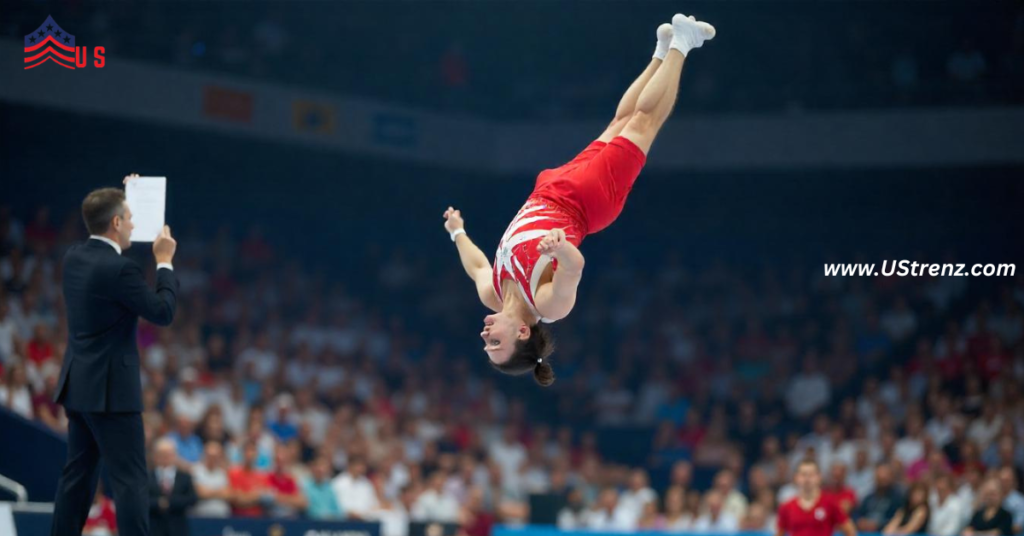
How many times can gymnast step out of bounds
Introduction
Gymnastics is a sport that demands control, accuracy, and a thorough knowledge of the regulations.how many times can gymnast step out of bounds during a routine is one important guideline that is regularly questioned. Whether in vault landings or floor exercises, going out of bounds can have a big impact on your score and possibly decide the result of a competition. This article explores the nuances of this regulation, how it affects scoring, and how crucial it is to comprehend boundaries in gymnastics.
Being Aware of the Out-of-Bounds Rule
For gymnastics to remain fair and disciplined, the out-of-bounds rule is essential. The performance area for floor routines is delineated by a boundary line, and it is deemed a violation to cross this line. However, how many times can a gymnast step out of bounds before it becomes noticeable? Although a gymnast is technically allowed to step out of bounds as many times as they like, each infraction carries a deduction. The majority of current scoring rules deduct 0.10 for each step that goes out of bounds. Throughout the exercise, judges pay close attention to the gymnast’s body position and foot placement. The deduction could be quadrupled if both feet touch down outside the line. Gymnasts must comprehend these guidelines in order to prevent losing important competition points.

Year-by-Year Evolution of the Out-of-Bounds Regulation
Over time, the out-of-bounds rule has changed. The following table lists the most significant adjustments and advancements:
| Year | Development |
| 1970 | In gymnastics, boundaries were initially used to guarantee a uniform space for floor routines |
| 1980 | International competitions established a formal 0.10 deduction for every step out of boundaries. |
| 1997 | Changes were made to enable judges to verify out-of-bounds offenses using slow-motion playback. |
| 2006 | To make deductions for repeated steps out of bounds in a single procedure more clear, the FIG Code of Points was enlarged. |
| 2017 | Stricter rules were introduced, with a focus on deduction for both feet falling outside the line. |
| 2022 | In top tournaments, digital monitoring devices are used to precisely track out-of-bounds steps. |
How Judges Address Violations of the Boundaries
Judges follow certain procedures for determining how many times a gymnast can step out of limits. Out-of-bounds infractions result in cumulative deductions. The deduction is 0.20, for instance, if a gymnast steps out twice during a performance. When combined with other sanctions like missing components or incorrect form, these deductions can drastically reduce the final result. In elite contests, judges are taught to pay great attention to boundary lines and frequently rely on video assessments. Some contemporary contests even employ electronic sensors to automatically identify boundary violations. The gymnast’s alertness and discipline are still crucial for preventing these expensive mistakes, even with the introduction of technology.
Why Do Gymnasts Cross Boundaries?
A gymnast may step out of limits for a variety of reasons. These consist of:

Overpowered Tumbling Passes
A gymnast may overshoot the landing area during a floor routine if they provide too much power during tumbling passes.
Loss of Balance
Mistakes outside the performance area might be caused by landing mistakes.
Problems with Spatial Awareness
Boundary breaches may result from misjudging the distance or trajectory during spins and flips. To reduce such errors, coaches work closely with gymnasts to enhance their balance and spatial awareness. Stepping out of bounds can be considerably decreased with a well-practiced exercise.
Ways to Prevent Crossing Boundaries
Gymnasts use a variety of strategies to stay inside the lines. The following are a few of the best tactics:
Controlled Power: To prevent overshooting the performance area during tumbling passes, strike a balance between strength and accuracy.
Targeted Training: A gymnast’s capacity to maintain boundaries is enhanced by exercises intended to mimic boundary awareness.
Appropriate Choreography: Coaches make sure that routines are planned with the vicinity of boundaries in mind.
Mental Focus: To prevent errors, gymnasts work on staying focused during crucial situations.
Gymnasts can greatly lower their risk of going out of bounds by becoming proficient in these methods, which will improve their performance and score.
Repercussions of Repeated Boundary Violations
Stepping out of limits repeatedly might have serious repercussions. The number of times a gymnast can step out of bounds is unlimited, but the cumulative penalty can significantly reduce their score. These mistakes can spell the difference between missing the podium completely and winning a medal in close competitions. A gymnast’s discipline and preparation may also be negatively impacted by repeated infractions. Coaches frequently utilize these situations as teaching opportunities, stressing the value of learning the basics and maintaining composure under duress.

FAQs how many times can gymnast step out of bounds
In a routine, how many times can gymnast go out of bounds?
The number of times a gymnast can step out of bounds is not strictly capped. Nevertheless, there is a cumulative deduction of 0.10 for each infraction.
Is there a bigger penalty for stepping out with both feet?
Yes, the deduction for that particular infraction is doubled to 0.20 if you step out with both feet.
Do all events have the same out-of-bounds deductions?
No, as boundary lines are only used in this event, the rule mostly applies to floor procedures. However, if the gymnast’s feet land outside the allotted area during a vault or beam landing, comparable deductions can be applicable.
How can gymnasts stay inside the lines?
By concentrating on controlled power, honing spatial awareness, and carefully planning routines to stay inside the boundaries, gymnasts may prevent going beyond the bounds.
Are out-of-bounds infractions consistently detected by judges?
Generally speaking, yes. Digital sensors and video checks help ensure precision in high-level competitions, and judges are taught to pay great attention to border lines.

Conclusion
It’s critical to comprehend the significance of adhering to the performance restrictions in gymnastics.how many times can gymnast step out of bounds but each infraction carries a deduction that can mount up rapidly. This guideline highlights the importance of accuracy, concentration, and thorough planning in all daily tasks. Athletes and coaches continue to adjust to these rules as the sport develops, guaranteeing fair competition and demonstrating the extraordinary discipline needed for gymnastics.
Read more about Sports on our website UStrenz



